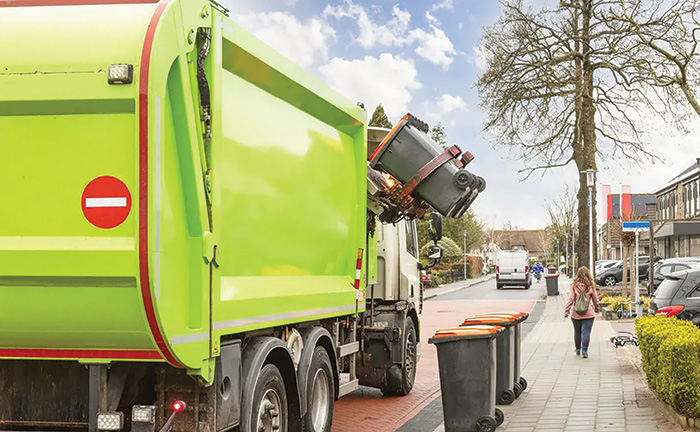The next time a waste collection vehicle passes by, remember the vital role of the transport planner. They may work behind the scenes, but the impact of their work resonates across our urban landscapes, within the waste and recycling industry, and our planet.
By Robert Hovhannisyan
Every day, hundreds of vehicles navigate our cities, collecting waste materials in a seemingly effortless routine. This is far from a simple endeavor. This complex exercise in logistics and planning, playing out quietly in the backdrop of urban life, starts at sunrise and does not stop until every waste container has been serviced.
Fleets of vehicles are consistently in motion, waste materials are picked up from numerous customer locations, and transport planners strategically orchestrate the entire operation like a well-oiled machine. This is an environment where efficiency is king and where success hinges on transport planners’ ability to balance numerous constraints and execute seamless planning.
Spotlight on Transport Planners
Transport planners and dispatchers form the crucial connection between customers, drivers, and internal departments. They manage the journey of waste from your bin to processing plants and eventually to recycling or disposal. They handle the day’s operations while planning for the week, month, and even the year ahead.
Beyond their daily tasks of planning and optimizing routes or managing drivers, transport planners have a multitude of responsibilities. They tackle rush orders, coordinate equipment maintenance, conduct regular audits for compliance, and ensure the smooth execution of evolving regulations. It is a delicate, high-stakes game of logistics, where each decision carries weight, and every minute counts.
Transport planners are the first point of contact for drivers, offering clear instructions and support when things deviate from the plan. Their role also extends into the realm of data and analytics, where they use technology and data to guide decision-making and shape sustainable, efficient waste management practices.

Photo courtesy of AMCS.
New Solutions to Boost Productivity
A deep understanding of the essential role of transport planners based on years of feedback has inspired a suite of features designed to enhance the productivity and decision-making capabilities.
First, a tool that transforms the way transport planners view and group jobs provides an eagle-eye view of all tasks, organized by material and container type. Equipped with robust filtering and sorting capabilities, planners can now strategize and schedule with a level of precision that was previously unattainable.
Next, a tool that revolutionizes job assignment and route planning is akin to corralling jobs on a digital map. This function allows dispatchers to select and allocate multiple unassigned jobs with a simple, visual selection gesture. It is the equivalent of swapping a manual, time-consuming task with a streamlined, user-friendly solution.
By providing a visual interface for job selection, this function not only speeds up the dispatching process, but also enhances strategic decision-making. Dispatchers can visually assess the geographical distribution of tasks, optimizing route allocation based on proximity and urgency. The benefits? Reduced fuel costs, quicker response times, and a tangible boost in operational efficiency.
By automating job-to-route assignments, you can show only compatible routes and suggest the nearest stops. For businesses managing round and roll-off schedules, scheduling support simplifies the addition of drivers for roll-off work.
Innovation does not stop with dispatch efficiency. Artificial intelligence driven, computer vision solutions have been integrated to leverage automated revenue generation for overfill and contamination events. This capability, along with dashboards that offer a granular overview of such events, provides invaluable insights for informed decision-making and follow-up actions.
Creating Business Value and Enhancing User Experience
Enhancements and capabilities improve productivity for planners and can lead to better use of fleet and staff resources. This enhances customer service. Higher fleet use means more service capacity, offering the potential for increased sales revenue and margins.
Upcoming changes in fleet maintenance promise to deliver a modernized user experience in line with improving navigation and reducing training costs, resulting in promoting usage with fewer calls for support, and streamlining business processes. These solutions also enable transport planners to master the art of logistics and drive their companies toward unprecedented efficiency and growth.
Shaping a Cleaner, Greener Future
The next time a waste collection vehicle passes by, remember the vital role of the transport planner. They may work behind the scenes, but the impact of their work resonates across our urban landscapes, within the waste and recycling industry, and our planet.
By enhancing their productivity and supporting their complex role, we are not only improving their work, but we are also reshaping the face of waste management and contributing to a cleaner, greener future. | WA
Robert Hovhannisyan is Product Marketing Manager for AMCS. For more in-depth details about the new features and enhancements, AMCS invites you to explore their release highlights document (https://www.amcsgroup.com/media/y4jgws1e/amcs-platform-summer-release-2023-highlights-brochure.pdf. This resource provides a comprehensive look at how their latest innovations are transforming the transport planning process in the waste and recycling industry. Robert can be reached at [email protected].
